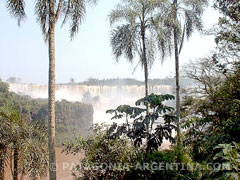The Misiones Jungle, which surrounds the Falls, is one of the most bio-diverse areas of the world. Know the species that live there and which ones are in danger.

The main characteristic of the flora is that there are multiple layers of it, one on top of another, from the forest floor to the canopy of the highest trees. Not only do the tops of the trees touch, but more plants hang from their branches, making it impossible to see the blue of the sky in some places.
One of the more typical species of the Park is “Palo Rosa” (pink stick) which grows more than 40 meters high, dwarfing even the trees. It is named for the color of its wood, which is even more pronounced when it is recently cut. Due to its declining numbers it has been proclaimed National Monument.
This giants live side-by-side with another more common species, the palm tree, which grows in groups. The internal trunk of this plant is edible and very tasty, but its extraction causes the tree to die, which is putting the species in danger of extinction.
Other common plants are orchids, the “guatambú”, the “pindó” and other hanging species. And don’t forget about the ceibo, a tree whose red blossoms are the national flower of Argentina.























